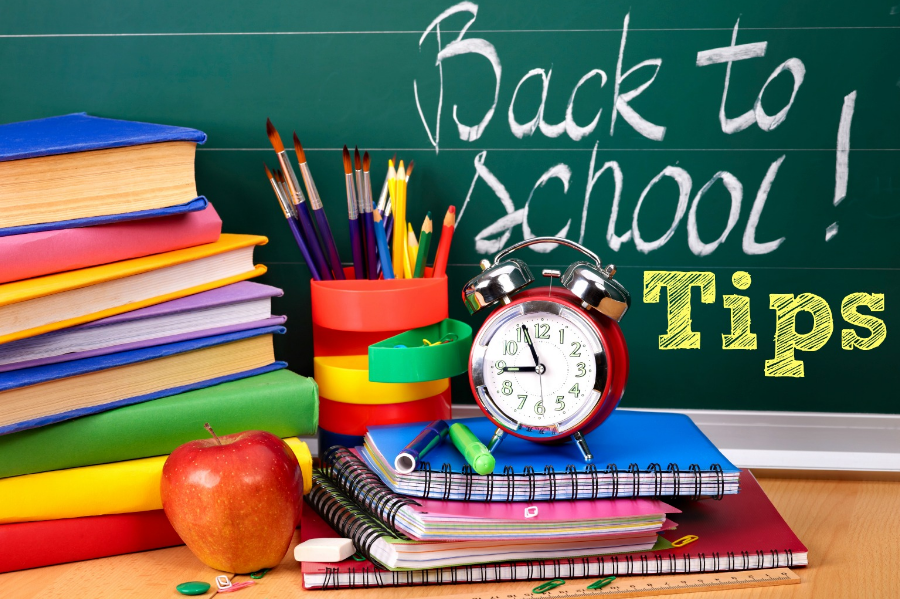It’s almost that time again! The kids are heading back to school and now, more than ever, is an important time to get your children practicing healthy habits!
#1 – Make sure your child gets plenty of rest.
 Rest is vitally important for a child’s growth and development. Most of all, getting enough sleep is essential for boosting immunity and brain function. When a child or teen is sleep deprived, it impacts alertness, learning ability, memory, mood and behavior. A couple of weeks prior to the first day of school have your child begin going to bed and waking up earlier. This will help the body adjust to a new sleep schedule before starting the
Rest is vitally important for a child’s growth and development. Most of all, getting enough sleep is essential for boosting immunity and brain function. When a child or teen is sleep deprived, it impacts alertness, learning ability, memory, mood and behavior. A couple of weeks prior to the first day of school have your child begin going to bed and waking up earlier. This will help the body adjust to a new sleep schedule before starting the
school year, thus preventing fatigue during class time.
How much sleep your children need will depend on their age. Children 3 to 6 years old need approximately 10 to 12 hours of sleep per day. For 7 to 12 year olds, 10 to 11 hours of sleep per day are recommended. For teenagers, 8 to 9 hours of sleep are needed. Remember also that children and teens may need short naps after school to adjust to their new schedules, especially if they are participating in athletic practices.
#2 – Make sure your child eats a nutritious diet.
 Just as much as lack of sleep, food plays a critical role in a child’s concentration, energy and mood levels. Eating a proper combination of phytonutrients and healthy omega-3 fats will help boost your child’s immune system and thus, protect your child from illness. So, here are some helpful tips for healthful eating:
Just as much as lack of sleep, food plays a critical role in a child’s concentration, energy and mood levels. Eating a proper combination of phytonutrients and healthy omega-3 fats will help boost your child’s immune system and thus, protect your child from illness. So, here are some helpful tips for healthful eating:
• Try to encourage your child to eat a healthy breakfast. Rather than eating cereal, pastries or other processed foods, have your child eat protein (eggs, turkey bacon, etc.), fruit, yogurt and/or oatmeal. A good night of restful sleep followed by a healthy morning meal will help balance your child’s blood sugar levels, thereby enabling him/her to stay focused during the school day.
 • If possible, pack your child’s lunch rather than purchase cafeteria or junk foods. You can control your child’s nutrition by preparing lunch yourself. Include nutritious foods such as lean meats, vegetables, fruits, organic cheeses, hummus, yogurt, etc. and avoid processed crackers, sweets and candies. Remember to pack a variety of foods so your child gets balanced nutrition.
• If possible, pack your child’s lunch rather than purchase cafeteria or junk foods. You can control your child’s nutrition by preparing lunch yourself. Include nutritious foods such as lean meats, vegetables, fruits, organic cheeses, hummus, yogurt, etc. and avoid processed crackers, sweets and candies. Remember to pack a variety of foods so your child gets balanced nutrition.
• If it is not realistic with your schedule to pack your child’s lunch every day, discuss the benefits of proper nutrition and encourage healthy food choices while at school – avoid sodas, vending machine snacks and sugary treats.
• Since children need a variety of nutrients each day, make sure your child is eating a “rainbow” of fruits and vegetables at home. Provide nutritious snacks and a healthy dinner. That way, regardless of how healthy (or poorly) your child ate at lunchtime, he/she will be getting the phytonutrients needed for strong immunity.
 • Make sure your child drinks plenty of water every day, especially when playing outside or attending athletic practices. For teens involved in sports activities, monitor for signs of dehydration: dizziness, light-headedness, confusion, thirst, dry mouth, nausea, vomiting, or extreme fatigue. Tell your teen to watch for sweating during practice. If your teen stops sweating, this is a sign of severe dehydration; your teen needs to quit working out, get in the shade, and start drinking water (not sports drinks). Keep in mind that dehydration itself can be a symptom of a more serious condition, such as diabetes. If your young child or teen experiences repeated bouts of dehydration with no obvious cause, check with a doctor for further testing.
• Make sure your child drinks plenty of water every day, especially when playing outside or attending athletic practices. For teens involved in sports activities, monitor for signs of dehydration: dizziness, light-headedness, confusion, thirst, dry mouth, nausea, vomiting, or extreme fatigue. Tell your teen to watch for sweating during practice. If your teen stops sweating, this is a sign of severe dehydration; your teen needs to quit working out, get in the shade, and start drinking water (not sports drinks). Keep in mind that dehydration itself can be a symptom of a more serious condition, such as diabetes. If your young child or teen experiences repeated bouts of dehydration with no obvious cause, check with a doctor for further testing.
#3 – Teach your child proper hand washing.
To reduce the risk of spreading illness at school, nothing beats proper hand washing with soap and water. The National Center for Infectious Diseases reminds everyone that more than a common cold can be caught through the spread of germs – some serious diseases such as hepatitis A, meningitis, and infectious diarrhea are easily spread without proper hand washing. Make sure your child distributes the soap evenly over the hands and lathers it in between the fingers. Scrub well for approximately 20 seconds. Then, rinse thoroughly with warm water. When throwing away paper towels, try to not touch the garbage can.
Besides how to wash their hands, teach your children when to wash their hands:
• Before eating food
• After using the restroom
• After blowing their nose, coughing or sneezing
• After performing science labs such as touching an animal or mixing chemicals
• After throwing away garbage
• After playing outside or performing other recreation activities
While washing hands with soap and water is the best way to reduce spreading germs, hand sanitizing gels can also be utilized. So, be sure to add hand sanitizing gel to your school supply list.
#4 – Teach your child to avoid sharing food with friends at school.
 While sharing is a great concept, many bacterial infections such as the Streptococcus bacteria (causes strep throat) can be passed through food. The same is true of sharing straws or drinks with other people. Therefore, teach your children to avoid sharing food or drinks with their friends.
While sharing is a great concept, many bacterial infections such as the Streptococcus bacteria (causes strep throat) can be passed through food. The same is true of sharing straws or drinks with other people. Therefore, teach your children to avoid sharing food or drinks with their friends.
Aside from passing germs, children should not share food due to food allergies and sensitivities. Many times, there are “hidden” ingredients in food items. For example, a child may bring lunch that has been prepared in peanut oil, which can be dangerous for another child with peanut allergies to consume. Furthermore, you need to ensure that your children are eating a well-balanced meal. Sharing or swapping items may be your child’s way of sneaking in sugar!
#5 – Teach your child to avoid sharing brushes or combs.
 In addition to treats, children also have a habit of sharing combs or hair brushes with their friends. Children should be taught not to use other people’s brushes nor should they allow their friends to use theirs. The sharing of combs and brushes can cause the spread of head lice which is more common in children during the school year.
In addition to treats, children also have a habit of sharing combs or hair brushes with their friends. Children should be taught not to use other people’s brushes nor should they allow their friends to use theirs. The sharing of combs and brushes can cause the spread of head lice which is more common in children during the school year.
#6 – Teach your child proper body mechanics.
Along with the risk of catching infections, students are at risk of back and neck problems from poor postural habits while sitting for extended periods of time in a desk or in front of the computer. Unfortunately, very few students have correct posture while sitting. The proper sitting posture is feet flat on the floor with the back naturally against the chair and the shoulders back and down. If possible, children and teens should be allowed regular breaks from sitting to walk and stretch. While this cannot always be controlled during school, taking periodic breaks during homework time is helpful for the back (and the brain!).
#7 – Don’t forget to exercise and limit T.V. time!
 Just because school is in session does not mean it’s time to ditch your family’s exercise routine. While you may not be able to make it to the gym, you can aim for some physical activity throughout the week – take walks together, go bike riding in the park, play hide and seek with smaller kids, play video games that require movement with teens, go bowling, etc. If week days are just too busy, plan your physical activity for the
Just because school is in session does not mean it’s time to ditch your family’s exercise routine. While you may not be able to make it to the gym, you can aim for some physical activity throughout the week – take walks together, go bike riding in the park, play hide and seek with smaller kids, play video games that require movement with teens, go bowling, etc. If week days are just too busy, plan your physical activity for the
weekend.
 Also, remember to limit television time after school. For elementary school children, 60 minutes of physical activity is recommended each day with no more than two hours of watching TV or playing non-movement video and computer games.
Also, remember to limit television time after school. For elementary school children, 60 minutes of physical activity is recommended each day with no more than two hours of watching TV or playing non-movement video and computer games.
These tips can be found at http://universityhealthnews.com/daily/natural-health-advisory-has-a-new-home-welcome-to-university-health-news/

